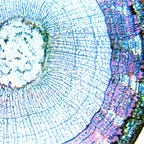Whales have been called floating trees for their ability to capture and store carbon — the CO2 equivalent of thousands of trees per whale according to the International Monetary Fund. Whales also support phytoplankton growth, which captures the CO2 equivalent of four Amazon forests. A one percent increase in phytoplankton productivity would result in the CO2-capture equivalent of two billion mature trees appearing year after year. “Climate activists would be better off trying to save whales rather than planting trees if they had to choose between those options,” some have noted.
A technological breakthrough for whale conservation and carbon offsets seemed within reach in 2016, but foundered. Now that modernization of the carbon market is attracting a “who’s who of accomplished entrepreneurs and investors from across Silicon Valley,” it may be time to revisit the past.
The experimental DAO of Whales — a Distributed Autonomous Organization, part whale, part computer code, funded by the National Science Foundation — first gave voice and agency to a pod of Orcas in the Pacific Northwest. The DAO could directly engage in a market exchange of resources through a series of automated contracts. With newfound autonomy to fundraise for their own conservation, it seemed that whales would, in time, join the carbon market.
If, for instance, whale size was X and the survival period was Y, then Z carbon offsets could theoretically be executed for ABC company through smart contracts, or a series of self-executing if-then statements. The greater the age and size of the whale, the greater the offset over time, verified through continuous monitoring. Satellite, drone, AI, and other non-invasive technologies, including tag deployments, Wildbook, and the DNA-gathering SnotBot, along with field study, could monitor species with jurisdictional support.
Monitoring a statistically significant population of whales — charismatic animals that provide an advanced direct air capture technology-as-a-service — would likely capture commercial interest and the public imagination. Monies would become available for wider-scale research into whales and their regenerative farming of phytoplankton to fund greater offset innovations.
Researchers have found that rebounded populations of whales could increase the productivity of phytoplankton in some subtropical waters by as much as 15% above the current level. Data for permanent, real, quantifiable, and verifiable whale carbon sequestration in the Southern Ocean is available from the National Institutes of Health.
The DAO of Whales did not survive, but the spirit of that effort persists. How might we reinvent it? Is a fully realized DAO necessary to endow whales with commercial rights in partnership with leading conservation NGOs? Would endowing whales with an almost-human agency make them seem more human, as recorded whale songs once did in the 1970s, launching a movement? Would whales be seen as digital pets by some to be protected and cared for? Starting with whales, how might we then reimagine carbon offsets as a public-facing, branded experience with corporate sponsor-buyers? One that would allow for premium pricing beyond the offset price for greater carbon leverage, with oversight provided by international financial institutions?
Corporate branded experiences for this type of performance-based, carbon-capture-as-a-service could consist of a menu of options, including engagement with citizen scientists of all ages, especially schoolchildren (see “Microplastic Madness”). Such options could allow companies to bundle multiple Environmental, Social, and Governance targets into an offset for added value at a higher price. High visibility could generate a compounding effect, with greater reputational risk to business practices that endanger whale viability, and greater rewards to those that enhance it. The time to act is now so how might we begin? Cost-effective carbon removal “technologies” do exist, ready to scale. We lose them to extinction at our peril.
